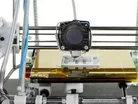7 facts regarding 3D Printing in construction

The construction industry has welcomed the use of innovative technologies to ensure the build of impressive, sustainable structures, which are built with reduced waiting time, provide more accurate results and ensure increased levels of safety.
3D Printing has become a popular phenomenon within construction, with various projects being built in this way, alongside the use of BIM and drone technology. The façade of the Europa-Haus in the Amsterdam Marine Quarter has recently been partially constructed through the use of 3D printing, at which DUS Architects were behind its construction, in addition to an 3D Printed Canal House, which is also being built within the region.
Here are our 7 facts regarding 3D Printing:
1. 3D Printing has been developed since the 1950s, but gained momentum through research at Loughborough University in the millennium. The process involves the layering of materials through the use of digital systems, such as a computer aided design (CAD) in order to create a sufficient model, which will then enable the prototype to be created.
2. The use of 3D Printing will work in line with BIM, to effectively support designers and architects in the construction of new builds.
3. The use of 3D Printing could reduce time and labour costs and ensure there is less waste within key projects by up to 60 percent. However, if materials such as steel are incorporated into key designs, a mould would be more beneficial to utilise to counteract scope creep.
4. 3D Printing will ensure the health and safety of workers, who might otherwise have to work in otherwise hazardous environments
5. The process would be sufficient in supporting areas which have been affected by human disasters, but also, NASA has incorporated the use of 3D printing buildings on the moon
6. Sustainable materials are utilised within the new builds, such as molten bio-degradable plastic, seen in the 3D Printed Canal House, alongside eco-concrete. The reduced transportation costs will also be an added benefit, reducing levels of CO2 emissions
7. The use of 3D Printing will provide increased benefits for overpopulated areas, who are in increased need of new homes to cater for densely populated areas
Follow @ConstructionGL
Read the November 2016 issue of Construction Global magazine
- OpenSpace: Paving the way for BIM technologyTechnology & AI
- Ora Developers & Orascom Construction sign US$103m agreementConstruction Projects
- WASP and Mario Cucinella Architects constructing 3D printed habitatBuilt Environment
- S-500: The 3D printer that AMT-SPETSAVIA says can print buildings 80m tallTechnology & AI



